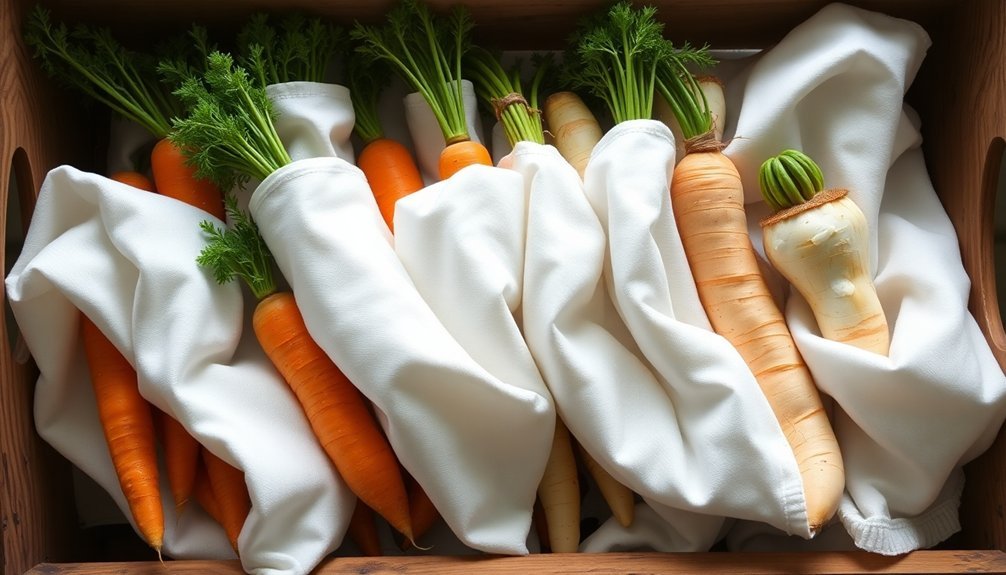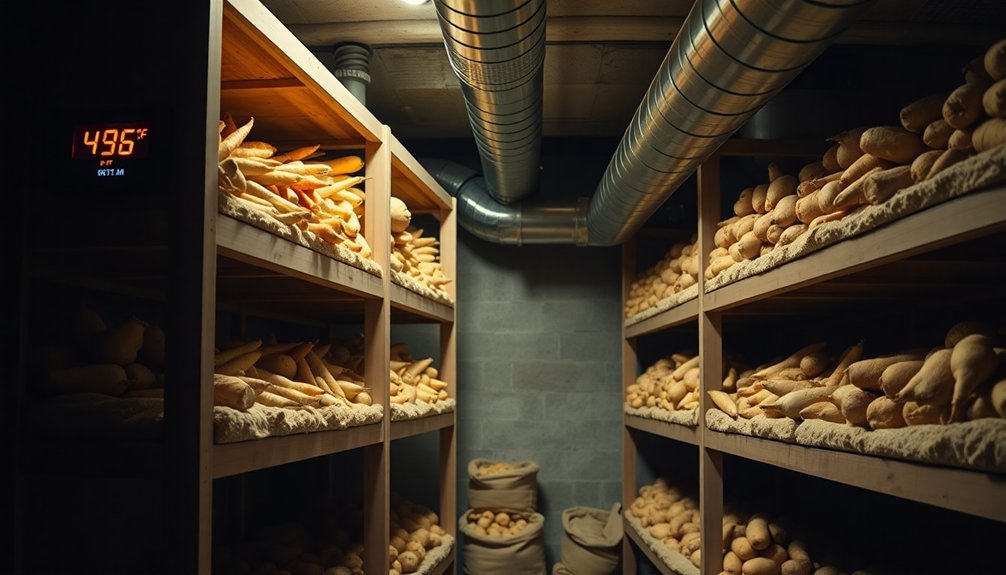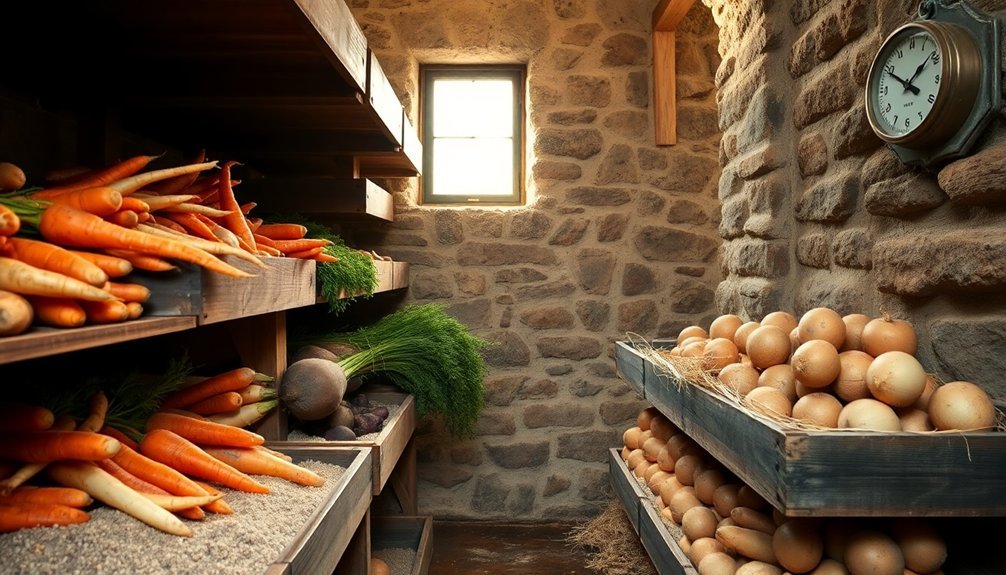Store your root vegetables properly to enjoy them for months using these five proven methods. You'll get the best results with a traditional root cellar setup that maintains 32-40°F and 90-95% humidity. For a simpler approach, try the sand storage layering method, which keeps vegetables fresh for up to six months. The damp towel wrapping technique works well in your refrigerator's crisper drawer, while ventilated container systems provide excellent airflow control. Temperature-controlled zone management helps you create ideal conditions for different vegetable types. Understanding these storage techniques in detail will help you maximize your harvest's longevity throughout the season.
Root Cellar Setup Basics

A root cellar's success depends entirely on four key elements: location, temperature, humidity, and ventilation.
When you're setting up your root cellar, choose a spot with naturally cool temperatures and high humidity levels. If possible, dig into a hillside for natural insulation, or use materials like straw bales and foam board to create an insulated space. Traditional building materials like wood and stone work excellently for construction.
You'll need to maintain temperatures between 32-40°F (0-4°C) to prevent freezing and premature sprouting. Install thermometers to monitor these levels closely.
The floor should be dirt or gravel on packed earth, which helps maintain the vital 90-95% humidity level your vegetables need to stay fresh. Use hygrometers to track moisture levels and adjust as needed.
Don't forget proper ventilation – it's essential for removing ethylene gas and preventing mold growth. You can install fans or a ventilation system to regulate air circulation.
Keep your cellar organized and clean, regularly checking for any signs of decay. Remove spoiled items promptly to prevent them from affecting other produce.
With these fundamentals in place, you'll create an ideal environment for long-term root vegetable storage.
Sand Storage Layering Method
Don't store your root vegetables with apples, as their ethylene gas emissions can affect storage life.
Store your vegetables in a cool, dark basement to maintain optimal preservation conditions.
When done correctly, this sand storage method can keep your root vegetables fresh for up to six months, making it an effective long-term preservation technique.
Damp Towel Wrapping Technique

For ideal freshness and longevity, wrapping root vegetables in damp towels creates a controlled environment that helps maintain essential moisture levels.
Before wrapping, you'll need to remove any greens and gently brush off soil without washing the vegetables. Trim the tops of beets, carrots, and parsnips, guaranteeing they're intact and free from damage.
When wrapping, use breathable materials like organic cotton or muslin cloth. Dampen the towel lightly – it shouldn't be soaking wet – and wrap your root vegetables carefully. Place them in your refrigerator's crisper drawer, maintaining temperatures between 32-40°F with high humidity around 95%.
For carrots and parsnips, you can place them in an open container with the damp towel draped over the top. Unlike other vegetables, avoiding potatoes in the freezer will help maintain better quality since they don't freeze well.
You'll find this method particularly effective for long-term storage. Carrots can last 4-6 months, parsnips 2-6 months, and celeriac 3-4 months when properly wrapped.
Check your stored vegetables every couple of weeks for signs of spoilage, and remove any that show deterioration. Remember to keep them away from vegetables like onions, which can speed up spoilage, and make sure there's adequate air circulation in your storage area.
Ventilated Container Systems
Through effective ventilation design, container systems play an essential role in preserving root vegetables by maintaining ideal airflow and humidity levels. You'll need to verify your storage containers have proper air circulation while maintaining 85-95% humidity for most root vegetables, except for onions and cucurbits that prefer drier conditions.
To maximize airflow, you'll want to use wooden crates or containers with built-in ventilation holes. You can automate the process using modern monitoring systems that'll adjust ventilation and humidity levels through your smartphone or PC, verifying peak conditions around the clock.
| Container Type | Benefits | Best For |
|---|---|---|
| Wooden Crates | Natural airflow, moisture balance | Potatoes, Carrots |
| Mesh Bags | Maximum ventilation, easy inspection | Onions, Garlic |
| Vented Plastic | Humidity control, stackable | Beets, Turnips |
Place water pans beneath your containers if you're using wooden or plastic systems on concrete floors to maintain proper humidity. For enhanced circulation, you'll want to position containers so there's space between them, allowing air to flow freely. Don't forget to install fans near cooling units to prevent condensation from dripping onto your vegetables and causing spoilage.
Temperature-Controlled Zone Management

Building upon proper container ventilation, maintaining precise temperature zones is fundamental to long-term root vegetable storage.
You'll need to maintain temperatures between 32-40°F (0-4°C) for most root vegetables, though potatoes thrive at slightly warmer temperatures of 40-50°F (4-10°C). Never let temperatures drop below freezing, as this will damage your produce.
You'll want to create distinct storage zones based on specific vegetable requirements. Keep carrots, beets, and parsnips together in the coolest area with 90-95% humidity.
Store potatoes separately in a slightly warmer zone, and remember to protect them from light exposure to prevent greening. Place onions in a dry, well-ventilated space after proper curing, and isolate turnips to prevent their strong odor from affecting other vegetables.
To maintain these temperature zones effectively, you'll need proper insulation and minimal temperature fluctuation.
Consider using underground storage methods like root cellars, which naturally maintain consistent temperatures. If you're using above-ground storage, monitor your zones regularly and use insulation materials to prevent temperature spikes.
Remember that consistent temperatures combined with proper humidity levels will greatly extend your vegetables' storage life.
Frequently Asked Questions
How Do Root Vegetables React When Stored Near Ripening Bananas?
You'll notice your root vegetables sprout and decay faster when stored near ripening bananas because they're exposed to ethylene gas. This natural hormone from bananas speeds up the ripening and aging process.
Can Frozen Root Vegetables Be Successfully Thawed and Stored Again?
You shouldn't attempt to store thawed root vegetables again. Once they've been frozen and thawed, they'll quickly deteriorate in quality and are prone to rot. It's best to use them immediately after thawing.
Do LED Grow Lights Affect Stored Root Vegetables Differently Than Fluorescent Lighting?
You shouldn't expose stored root vegetables to any light, whether LED or fluorescent. Both types will harm your vegetables equally by triggering unwanted photosynthesis and speeding up decay. Keep them in complete darkness.
Which Root Vegetables Can Be Stored Together With Aromatic Herbs?
You shouldn't store root vegetables with aromatic herbs at all. They'll absorb flavors and spoil faster. Keep your herbs separate from roots like carrots, potatoes, and beets to maintain their natural taste.
Why Do Some Root Vegetables Develop a Sweet Taste During Storage?
When you store root vegetables below 41°F, they'll convert their starches into sugars as a natural defense against freezing. This process, called cold sweetening, happens gradually over several weeks to protect plant cells.
In Summary
You'll find these five root vegetable storage methods easy to implement in your home. Whether you choose the traditional root cellar approach or opt for modern temperature control, proper storage will extend your harvest's life by months. Try combining different techniques based on your space and climate. Remember to check your stored vegetables weekly and remove any that show signs of spoilage to protect the rest.





Leave a Reply